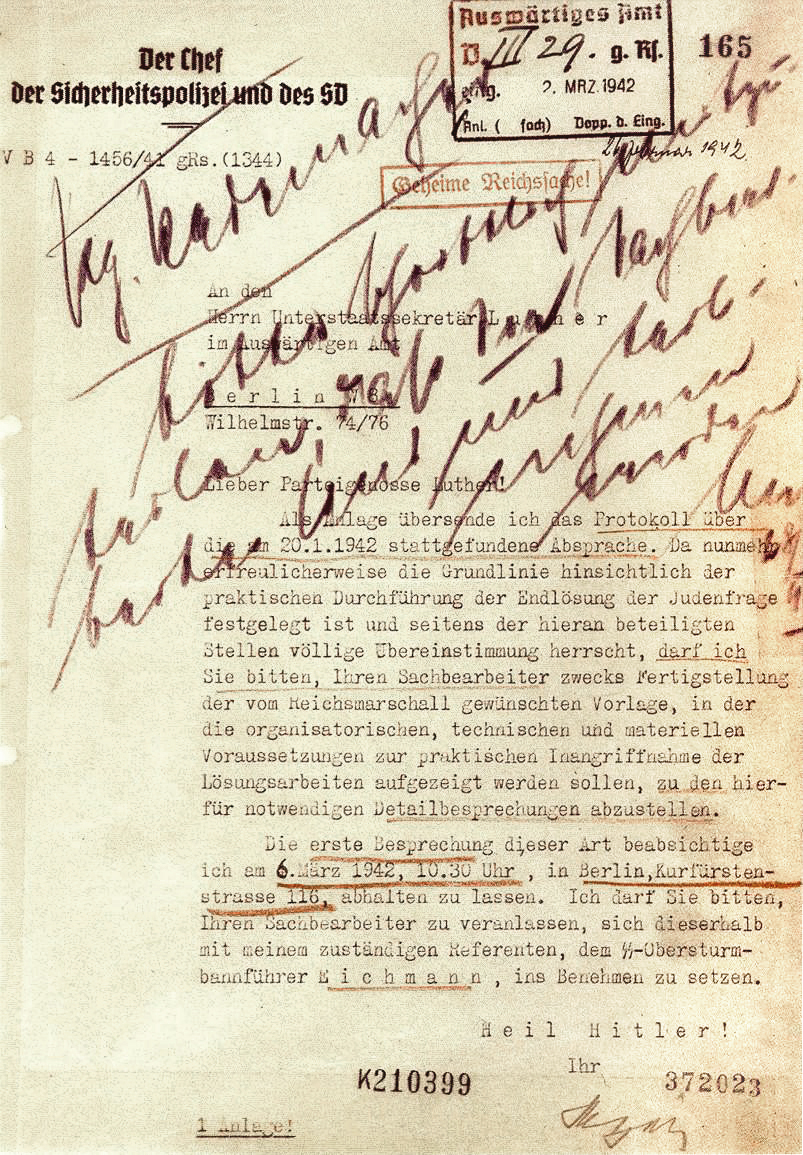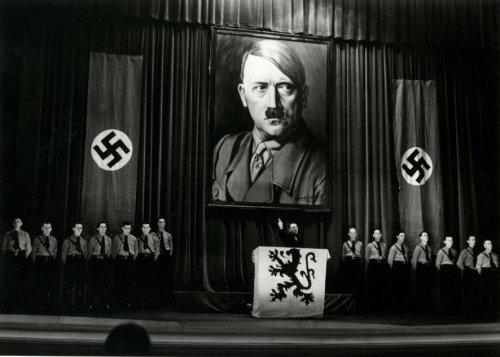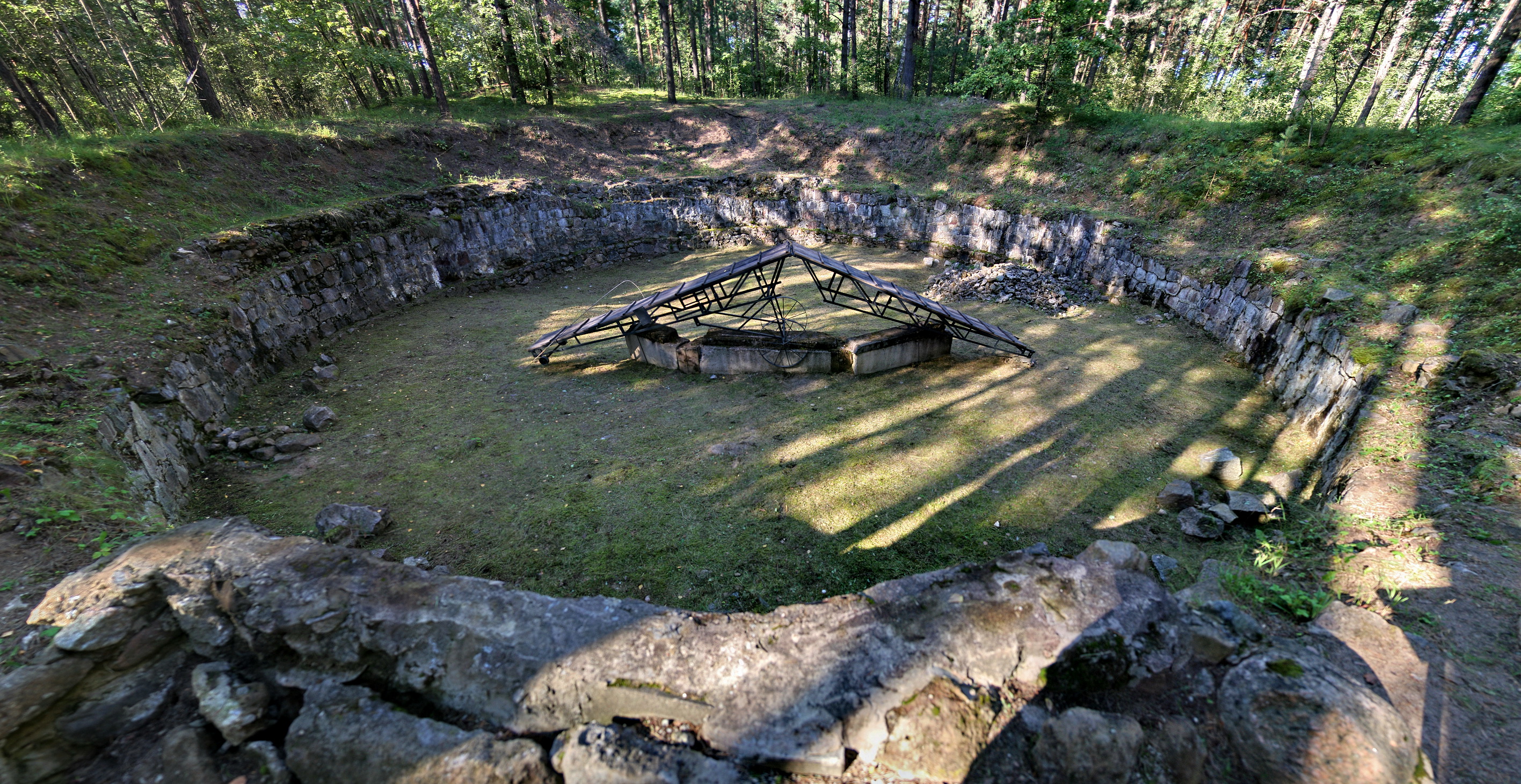|
Occupation Of Latvia By Nazi Germany
The military occupation of Latvia by Nazi Germany was completed on 10 July 1941, by Germany's armed forces. Initially, the territory of Latvia was under the military administration of Army Group North, but on 25 July 1941, Latvia was incorporated as Generalbezirk Lettland, subordinated to Reichskommissariat Ostland, an administrative subdivision of Nazi Germany. Anyone not racially acceptable or who opposed the German occupation, as well as those who had cooperated with the Soviet Union, was killed or sent to concentration camps in accordance with the Nazi Generalplan Ost. Persecutions Immediately after the establishment of German authority at the beginning of July 1941, the elimination of the Jewish and Roma population began, with major mass killings taking place at Rumbula and elsewhere. The killings were committed by the Einsatzgruppe A, and the ''Wehrmacht''. Latvian collaborators, including 500 to 1,500 members of the Arājs Kommando (which alone killed around ... [...More Info...] [...Related Items...] OR: [Wikipedia] [Google] [Baidu] |
Bundesarchiv Bild 183-L19397, Lettland, Riga, Begrüßung Der Deutschen Soldaten
The German Federal Archives or Bundesarchiv (BArch) (, lit. "Federal Archive") are the national archives of Germany. They were established at the current location in Koblenz in 1952. They are subordinated to the Federal Commissioner for Culture and the Media ( Claudia Roth since 2021) under the German Chancellery, and before 1998, to the Federal Ministry of the Interior. On 6 December 2008, the Archives donated 100,000 photos to the public, by making them accessible via Wikimedia Commons. History The federal archive for institutions and authorities in Germany, the first precursor to the present-day Federal Archives, was established in Potsdam, Brandenburg in 1919, a later date than in other European countries. This national archive documented German government dating from the founding of the North German Confederation in 1867. It also included material from the older German Confederation and the Imperial Chamber Court. The oldest documents in this collection dated back to the ... [...More Info...] [...Related Items...] OR: [Wikipedia] [Google] [Baidu] |
Generalplan Ost
The (; ), abbreviated GPO, was Nazi Germany's plan for the settlement and "Germanization" of captured territory in Eastern Europe, involving the genocide, extermination and large-scale ethnic cleansing of Slavs, Eastern European Jews, and other indigenous peoples of Eastern Europe categorized as "'' Untermenschen''" in Nazi ideology. The campaign was a precursor to Nazi Germany's planned colonisation of Central and Eastern Europe by Germanic settlers, and it was carried out through systematic massacres, mass starvations, chattel labour, mass rapes, child abductions, and sexual slavery. ''Generalplan Ost'' was only partially implemented during the war in territories occupied by Germany on the Eastern Front during World War II, resulting indirectly and directly in the deaths of millions by shootings, starvation, disease, extermination through labour, and genocide. However, its full implementation was not considered practicable during major military operations, and neve ... [...More Info...] [...Related Items...] OR: [Wikipedia] [Google] [Baidu] |
Mežaparks
Mežaparks () is a neighbourhood of Northern District in Riga, the capital of Latvia. It consists of a residential area to the South and a large urban park to the North of the same name – Mežaparks. The neighbourhood is located on the western shore of Lake Ķīšezers. The name is literally translated as "forest park". The neighbourhood and park were built in the early 20th century and the area was originally called . It was one of the world's first garden cities. It had large number of Art Nouveau and Eclectic villas for upper class inhabitants of Riga. During the Second World War, the Kaiserwald concentration camp was located in this park, and many Jews, Gypsies, Communists, and other opponents of Nazi rule were murdered in these woods. Today it is still one of the wealthier areas of Riga, the Mežaparks Great Bandstand hosts the Latvian Song and Dance Festival in early July every five years. Mežaparks is also host to the Riga Zoo and its lakeside locale allows f ... [...More Info...] [...Related Items...] OR: [Wikipedia] [Google] [Baidu] |
Kaiserwald Concentration Camp
Kaiserwald (Ķeizarmežs) was a Nazi concentration camp near the Riga suburb of Mežaparks, then part of Reichskommissariat Ostland, in modern-day Latvia. Kaiserwald was built in March 1943, during the period that the German army occupied Latvia. The first inmates of the camp were several hundred convicts from Germany. Following the liquidation of the Riga, Liepāja and Daugavpils (Dvinsk) ghettos in June 1943, the remainder of the Jews of Latvia, along with most of the survivors of the liquidation of the Vilna Ghetto, were deported to Kaiserwald. In early 1944, a number of smaller camps around Riga were brought under the jurisdiction of the Kaiserwald camp. Following the occupation of Hungary by the Germans, Hungarian Jews were sent to Kaiserwald, as were a number of Jews from Łódź, in Poland. By March 1944, there were 11,878 inmates in the camp and its subsidiaries, 6,182 males and 5,696 females, of whom only 95 were gentiles. Use of the inmates Unlike Auschwitz or T ... [...More Info...] [...Related Items...] OR: [Wikipedia] [Google] [Baidu] |
Czech Republic
The Czech Republic, also known as Czechia, and historically known as Bohemia, is a landlocked country in Central Europe. The country is bordered by Austria to the south, Germany to the west, Poland to the northeast, and Slovakia to the southeast. The Czech Republic has a hilly landscape that covers an area of with a mostly temperate Humid continental climate, continental and oceanic climate. The capital and largest city is Prague; other major cities and urban areas include Brno, Ostrava, Plzeň and Liberec. The Duchy of Bohemia was founded in the late 9th century under Great Moravia. It was formally recognized as an Imperial Estate of the Holy Roman Empire in 1002 and became Kingdom of Bohemia, a kingdom in 1198. Following the Battle of Mohács in 1526, all of the Lands of the Bohemian Crown were gradually integrated into the Habsburg monarchy. Nearly a hundred years later, the Protestantism, Protestant Bohemian Revolt led to the Thirty Years' War. After the Battle of White ... [...More Info...] [...Related Items...] OR: [Wikipedia] [Google] [Baidu] |
Riga Ghetto
Riga Ghetto was a small area in Maskavas Forštate, a neighbourhood of Riga, Latvia, where Nazis forced Latvian Jewish, Jews from Latvia, and later from the German "Reich" (Germany, Austria, Bohemia, and Moravia), to live during World War II. On October 25, 1941, the Nazis evicted the ghetto's non-Jewish inhabitants and relocated all Jews from Riga and its vicinity there. Most Latvian Jews (about 35,000) were killed on November 30 or December 8, 1941, in the Rumbula massacre. The Nazis transported a large number of German Jews to the ghetto; most of them were later killed in massacres. While Riga Ghetto is commonly referred to as a single entity, in fact there were several "ghettos". The first was the large Latvian ghetto. After the Rumbula massacre, the surviving Latvian Jews were concentrated in a smaller area within the original ghetto, which became known as the "small ghetto". The small ghetto was divided into men's and women's sections. The area of the ghetto not allocat ... [...More Info...] [...Related Items...] OR: [Wikipedia] [Google] [Baidu] |
Simon Wiesenthal
Simon Wiesenthal (31 December 190820 September 2005) was an Austrian Holocaust survivor, Nazi hunter, and writer. He studied architecture, and was living in Lwów at the outbreak of World War II. He survived the Janowska concentration camp (late 1941 to September 1944), the Kraków-Płaszów concentration camp (September to October 1944), the Gross-Rosen concentration camp, a death march to Chemnitz, Buchenwald, and the Mauthausen concentration camp (February to May 1945). After the war, Wiesenthal dedicated his life to tracking down and gathering information on fugitive Nazi war criminals, so that they could be brought to trial. In 1947, he co-founded the Jewish Historical Documentation Centre in Linz, Austria, where he and others gathered information for future war crime trials and aided Jewish refugees in their search for lost relatives. He opened the Documentation Centre of the Association of Jewish Victims of the Nazi Regime in Vienna in 1961, and continued to try to ... [...More Info...] [...Related Items...] OR: [Wikipedia] [Google] [Baidu] |
Andrievs Ezergailis
Andrew Ezergailis (; born 10 December 1930 in Rite Parish, died 22 January 2022 in Ithaca, New York) was a professor of history at Ithaca College, known for his research into the 20th-century history of Latvia, particularly of the 1917 Revolution and the Holocaust in Latvia."Ezergailis Honored by Latvia" '''', April 2006 In August 2007, Ezergailis was awarded the Cross of the , one of the highest honors of Latvia, for his contributions to understanding the hi ... [...More Info...] [...Related Items...] OR: [Wikipedia] [Google] [Baidu] |
Sicherheitsdienst
' (, "Security Service"), full title ' ("Security Service of the ''Reichsführer-SS''"), or SD, was the intelligence agency of the Schutzstaffel, SS and the Nazi Party in Nazi Germany. Established in 1931, the SD was the first Nazi intelligence organization and the Gestapo (formed in 1933) was considered its sister organization through the integration of SS members and operational procedures. The SD was administered as an independent SS office between 1933 and 1939. That year, the SD was transferred over to the Reich Security Main Office (''Reichssicherheitshauptamt''; RSHA), as one of its seven departments. Its first director, Reinhard Heydrich, intended for the SD to bring every single individual within the Third Reich's reach under "continuous supervision". Following Germany's defeat in World War II, the tribunal at the Nuremberg trials officially declared that the SD was a criminal organisation, along with the rest of Heydrich's RSHA (including the Gestapo) both individually ... [...More Info...] [...Related Items...] OR: [Wikipedia] [Google] [Baidu] |
Arajs Kommando
The Arajs ''Kommando'' (; ) was a paramilitary unit of the ''Sicherheitsdienst'' (SD) active in German-occupied Latvia from 1941 to 1943. It was led by SS commander and Nazi collaborator Viktors Arājs and composed of ethnic Latvian volunteers recruited by Arājs. The Arajs Kommando was a notorious death squad and one of the main perpetrators of the Holocaust in Latvia. The unit was involved in the mass killing of Jews in Latvia until 1942 when it was used in anti-partisan operations in Belarus and Russia. It was disbanded and merged into the Latvian Legion in 1943. Formation In July 1941, Nazi Germany began its military occupation of Latvia, already occupied by the Soviet Union at the time, shortly after the German invasion of the Soviet Union. One of earliest and most enthusiastic Latvian collaborators was Viktors Arājs, a former policeman and Latvian Army soldier. On 1 July, after the entry of the Germans into Riga, Arājs made contact with SS-''Brigadeführe ... [...More Info...] [...Related Items...] OR: [Wikipedia] [Google] [Baidu] |
Collaboration With Nazi Germany And Fascist Italy
In World War II, many governments, organizations and individuals Collaborationism, collaborated with the Axis powers, "out of conviction, desperation, or under coercion". Nationalists sometimes welcomed German or Italian troops they believed would liberate their countries from colonization. The Danish, Belgian and Vichy French governments attempted to appease and bargain with the invaders in hopes of mitigating harm to their citizens and economies. Some countries' leaders such as Henrik Werth of Axis member Hungary, cooperated with Italy and Germany because they wanted to regain territories lost during and after World War I, or which their nationalist citizens simply coveted. Others such as France already had their own burgeoning fascist movements and/or antisemitic sentiment, which the invaders validated and empowered. Individuals such as Hendrik Seyffardt in the Netherlands and Theodoros Pangalos in Greece saw collaboration as a path to personal power in the politics of their ... [...More Info...] [...Related Items...] OR: [Wikipedia] [Google] [Baidu] |
Einsatzgruppe A
(, ; also 'task forces') were (SS) paramilitary death squads of Nazi Germany that were responsible for mass murder, primarily by shooting, during World War II (1939–1945) in German-occupied Europe. The had an integral role in the implementation of the so-called "Final Solution to the Jewish question" () in territories conquered by Nazi Germany, and were involved in the murder of much of the intelligentsia and cultural elite of Poland, including members of the Catholic priesthood. Almost all of the people they murdered were civilians, beginning with the intelligentsia and swiftly progressing to Soviet political commissars, Jews, and Romani people, as well as actual or alleged partisans throughout Eastern Europe. Under the direction of Heinrich Himmler and the supervision of SS- Reinhard Heydrich, the operated in territories occupied by the ''Wehrmacht'' (German armed forces) following the invasion of Poland in September 1939 and the invasion of the Soviet Union i ... [...More Info...] [...Related Items...] OR: [Wikipedia] [Google] [Baidu] |




